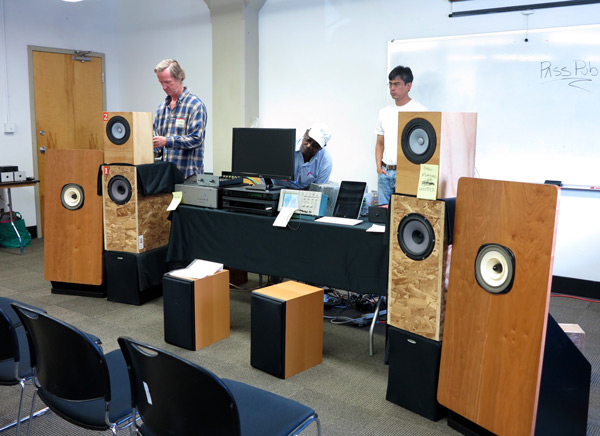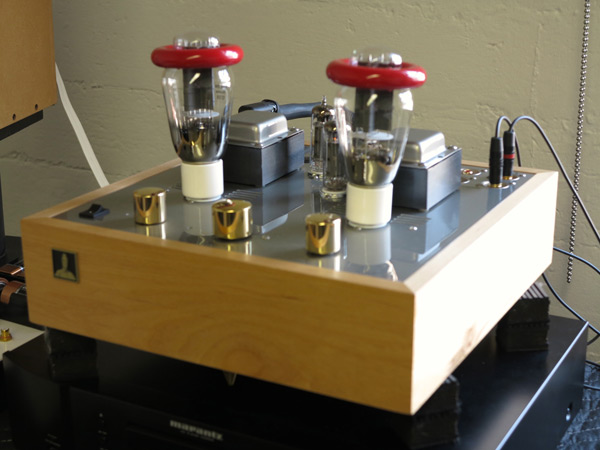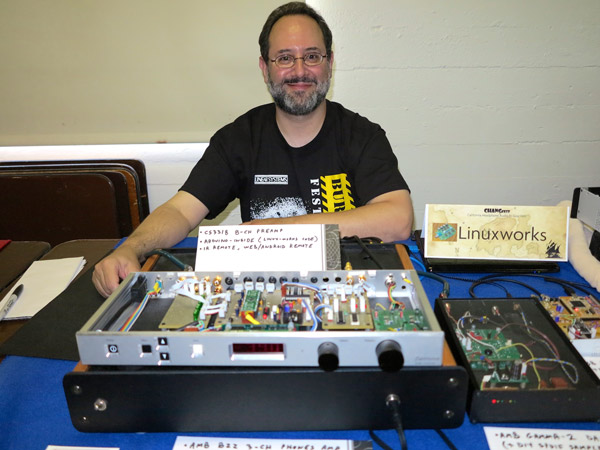Download
Popular Posts
-
Gibboni and the Gibbon: At Stereo Exchange’s annual Spring High-End Audio Show, Roger Gibboni (left) of Rogers High Fidelity debu...
-
Hey, we were in earthquake country, the land from which Carole King may have received inspiration to write, "I Feel the Earth Move...
-
John Atkinson and Stephen Mejias were unable to attend the Munich High End Show this year, so the call went out to the editors of Ste...
-
A reader once noted that I tend to stick with the same reference gear longer than most reviewers. In addition to Audience's Au24e i...
-
Today, Sony announced an end to production on all MiniDisc players. In a few years, MiniDisc production will cease as well. I know w...
-
The name sounds perfect . It fits neatly next to those of Messrs. Leak, Sugden, Walker , Grant, Lumley, and others of Britain's...
-
The Enigmacoustics company from Irvine in California has become renowned for the self-energized, horn-loaded Sopranino electrostatic su...
-
With the introduction of Audio Alchemy's Digital Transmission Interface (DTI) more than three years ago, the company created an ent...
-
If it's rare to go to an audio show and hear most of a company's products set up properly in multiple rooms, it's rarer sti...
-
There's nothing like highlighted text from Stereophile brother Art Dudley to get a fellow writer's attention. Then again, so...
Market information
Blog Archive
-
▼
2013
(510)
-
▼
October
(73)
- Audioquest Dragonfly DAC and Grado SR80i Headphone...
- GoldenEar Technology Aon 2 loudspeaker
- Opera Callas loudspeaker
- TAVES Toronto Starts Friday
- The Entry Level #35
- The Death of an Audiophile
- Recording of November 2013: Another Self Portrait ...
- Whetstone Audio's Rega Hootenanny
- John Zorn@60
- The 10th Annual Rocky Mountain Audio Fest
- VTL/Wilson/dCS—JA's Equal Best Sound at RMAF
- Resonessence Labs Does DSD
- Wavelength and Vaughn
- Bel Canto Looks Good in Black
- Scaena's Silver Ghosts at the Hyatt
- Kronos/Veloce/YG/Kubala-Sosna
- Grace from Volti Audio & BorderPatrol
- SimpliFi dems Klangwerk Speakers
- Paragon–Doshi–Wilson
- Mojo–Atomic Audio Labs–VH Audio
- Audio by Van Alstine amps & Salk speakers
- Low noise, superb sound from Hegel
- HiFi Imports dems Venture, Weiss, Thrax, Enklein
- Aaudio Imports & the enormous Lansche 8.2 speakers
- Gold Sound Premiers Focal Speaker
- Vapor Audio & BMC at the Hyatt
- German Physiks–Vitus–Purist
- Crescendo Hits Some Peaks
- DSD Done Right: Acoustic Sounds' Super HiRez downl...
- CANJAM’s Major Statement
- Brodmann and Electrocompaniet
- Channel D Rocks Rocky Mountain: Goes High, Low, & ...
- JansZen, Bryston, exaSound
- New Gear from Astell&Kern
- Zesto Premiers Power Amplifier
- Xact Audio Showcases Rockport Speakers
- Daedalus–ModWright–WyWires
- Jeff Rowland's Aeris DAC Impresses
- Lawrence's Double Bass
- Dean Peer OKs Trenner & Friedl’s Pharoah
- TAD Goes Blue Smoke
- A New Native DSD Download Site
- Tannoy+VAC+Esoteric+Shunyata=Transcendence
- Zu and Peachtree: A Felicitous Pairing
- Dynaudio + T+A = Power, Speed, & Grace
- AVM & Gauder Akustik
- Legacy & AVM
- Computer Audio—the Big Picture
- Opus 3's Jan-Eric Persson
- Puresound amplification and phono accessories
- Grimm Audio reaches the US
- Nordost’s New Sort Füt
- Sonus faber Scales the Heights
- Parasound, Monitor Audio, Kimber, and more
- Your Final System
- Cary and ADAM Audio
- McIntosh’s New Babies
- DALI's First Active Loudspeaker
- Party in the Music Hall room
- Acoustic Signature Wow
- The 10th RMAF: Pre-Show Libations
- Wharfedale Diamond 10.7 loudspeaker
- Burning Amp's Slow Burn
- The Entry Level #34
- Audio Research Reference CD9 CD player/DAC
- Aesthetix Saturn Romulus DAC/CD player
- David and his Missing Package
- The 10th Rocky Mountain Audio Fest Starts Friday
- AXPONA Acquired by JD Events
- The Roots and Elvis
- Jenny Hval at the Mercury Lounge
- Darcy James Argue and His Steampunk Big Band
- Major Changes for Montreal & New York Shows
-
▼
October
(73)
Burning Amp's Slow Burn

Central to every Burning Amp is Nelson Pass (above), whose boundless generosity and support to DIYers worldwide has made him a father figure of sorts. (The gray hair helps.) This year, in addition to his presentation, "The Simplest Amp and Other Stories," Pass's Burning Amp Pass Pub room was transformed into an Amp Camp Amp Wonderland, where various amp designs mated with "a bunch of loudspeakers that you can make" (below)

Pass took infinite delight in showing his "simplest amp," created with two transistors, a transformer and wire—the fewest parts he'd been able to use to make it work. "Of course, I tossed off all the complexities to the external power supplies and five switches," he told me. The sound, which I only heard through I'm-not-sure which speakers at the end of my four-hour visit, was amazingly pure. It also displayed gorgeous warmth, albeit without the color that power conditioning, superior cabling, isolation supports, more expensive parts, and other audiophile prerequisites can coax out of components.
How lovely it was to discover Pass playing, not the usual Diana Krall, Jacintha, and "whatever I grabbed in the rush" demo fare, but rather an eclectic audition CD that included, in this order, selections from Chick Corea, Ladysmith Black Mambazo, and Philip Glass's Akhnaten. When, other than when Stephen Mejias or someone as adventurous chooses the music, can you hear such a refreshing musical mélange at a show?

Pass shared the room with Dana Brock (above), who hosts the DIY Amp Camp/Speaker camp at his Northern California spread in Sebastopol. (It's either amps or speakers, depending upon the year.) Although Dana's son, Nelson, who exhibited last year, was off at his freshman year at MIT, his other son, a UC Berkeley student who was so ridiculously tall that I couldn't read his name tag, was helping out.
In the course of a day, for the cost of materials only, participants in the last Amp Camp managed to build an amp whose plans are available from Pass's article on the First Watt and Amp Camp sites, and whose kit is available from DIYAudio. The amp uses the same switching power supplies that power laptop computers. Nelson reports that, last year, 24 people showed up, including a teenager, "old farts like me," and some who had never before yielded a soldering iron. "It was pretty exciting to watch people get the bug," he said.
One of Pass and Brock's goals was to cycle through various 4" drivers, and ask visitors to decide which one to use at the next Speaker Camp. Among the many speakers doing the honors were Nelson's open baffles. Whenever a new driver or Amp Camp special was inserted into the chain—I heard both Amp Camp Amp #1 (ACA1), a 5W class-A baby with a distinctive black and red housing, and Pass' Simplest—people listened attentively.

You never know. . .
Due to limited time, I visited the big room only long enough to see Scott Wurcer discussing the history of op-amps, and skipped both Pass's presentation and Jan Didden's on the Smyth Realizer process for headphone listening. Instead, I encountered Parasound's Richard Schram (above right), who posed for a photo with Jason Donald, administrator of the DIY Audio site (above left), and Paul Norton of Linear Systems (above center). Schram was especially enthused about Linear Systems' limited-release LSJ74 P-channel JFET, which fabled circuit designer John Curl pushed them to manufacture. It's available exclusively through the DIY Audio store. Also on display were the new LSK49 dual N-channel JFET, and LSK189 single N-channel JFET.
"For some people, these products are like Brittany Spears without the underwear," Norton quipped. Making sure his belt was fastened tight, Schram followed suit with, "Everyone has been breathing fumes since Toshiba ceased manufacturing their JFETs—everyone except for people like Charlie Hanson of Ayre, who bought up gobs of them. We're all grateful for Linear Systems, who has made them available once again."

Onward
In another demo room, I encountered architect/DIY hero Mark Cronander (Variac) pictured above, who has sustained Burning Amp with other equally valiant volunteers for the past few years. First he proudly showed me the amp his 8-year old nephew built at Amp Camp 2012. Then we turned to his mini-skyscraper version of Nelson Pass' First Watt 100Wpc F-4 clones, which he demed in an all-balanced system that included a compatible, high output preamp designed by DIY moderator Stuart Yaniger, an Oppo BDP-105 disc player, and Basszilla speakers designed by erstwhile Stereophile writer Dick Olsher. (Plans are available for a whole $30.)

"I'm very proud that I pushed him to come up with this new model," Cronander said. From its Aurum Cantus 2.5" ribbon tweeter, Fostex 8" midrange unit, and Eminence 15" woofer I heard sound that was surprisingly smooth, given that most of Cronander's CDs were of early digital-hell provenance, and the presence of hum caused by a faulty soldering joint in one of the preamp's 200 (!) soldered step attenuator connections (above).

I also took a brief listen to a ridiculously loud blast of Diana Krall on Koho of San Francisco's field-coil loudspeakers (above). This year, these imposing DIY babies were tuned up with custom modified field-coil drivers using the original paper cone and alnico magnets.

Siegfried Linkwitz
In the room traditionally occupied by speaker design legend Siegfried Linkwitz and his gracious wife, Eike (above), I also encountered Jack Vad, recording engineer for the San Francisco Symphony. Together we auditioned Linkwitz's LX-521 open-baffle loudspeakers, whose plans are available for purchase.
"Instead of an analog signal processor, I'm using an all-digital mini DSP crossover developed by Dave Reite," he said. "It duplicates the transfer function of the analog circuitry and sounds the same to my ears." Paired with an old Oppo used as a transport and an ATI 6012 amplifier, the speakers masterfully controlled deep percussion, and also excelled in the midrange.
"I'm done with listening to other loudspeakers," Linkwitz declared. "I can tell by inspection what's basically wrong with every loudspeaker; I don't need to hear it. All box speakers radiate sound in a way that is not friendly to the brain. Stereo is like a magician's trick; the auditory illusion only exists in the brain. To create it, you need to hide the speakers and the living room and the system. Since you usually can't, the trick is to remove the cues that tell the brain that speakers and a living room are present. Our brains can fill in missing pieces, but they can't remove something that shouldn't be there.
"What this means is that loudspeakers have to send the same sound into each direction at all frequencies. Reflected sounds should not distract, and must be delayed by proper speaker placement. They must arrive later than the direct sounds so that the brain can process and ignore them as separate acoustic events. The common box loudspeaker radiates in all directions at low frequencies and beams at high frequencies. My loudspeakers have frequency independent directivity to address this issue."
More discoveries
Across the hall, I encountered first-time exhibitor Mario Yrún of San Rafael, who teaches finance and accounting at City College San Francisco. Yrún had housed a Mark Audio Alpair 12p paper cone driver in a pensil cabinet that he built using an open source cabinet design by Scott Lindgren. Into the high end since he was a kid, Yrún began restoring old Marantz receivers 5 or 6 years ago, and soon got into speaker building.

Cronander, who pairs DIY exhibitors together based on component capability, had matched Yrún with Cary Chin, a San Francisco resident who currently manages shipping and receiving at a toy store. Chin, as it turned out, had taken Yrún's finance class a few years earlier. How cool is that? Chin's babies, a Bottlehead Sex amp and Bottledhead BPre (above) with upgraded parts from Kevin Olson, helped create a very nice sounding system.
In the final room stood a repeat system from software engineer Ti Kan of AMB Laboratories, including his open source design AMB Beta 24 power amp and micro-controller controlled Alpha 10 preamp. Next to him again resided network programmer Bryan Levin of Sercona Audio, who showed a proof-of-concept, open source multi-channel preamp controller (below).

After several hours of listening and schmoozing, I skipped the annual Big Give-Away feeding frenzy, and headed home to walk the pooches. Here's to Burning Amp 2014.
Source : stereophile[dot]com


Comments[ 0 ]
Post a Comment